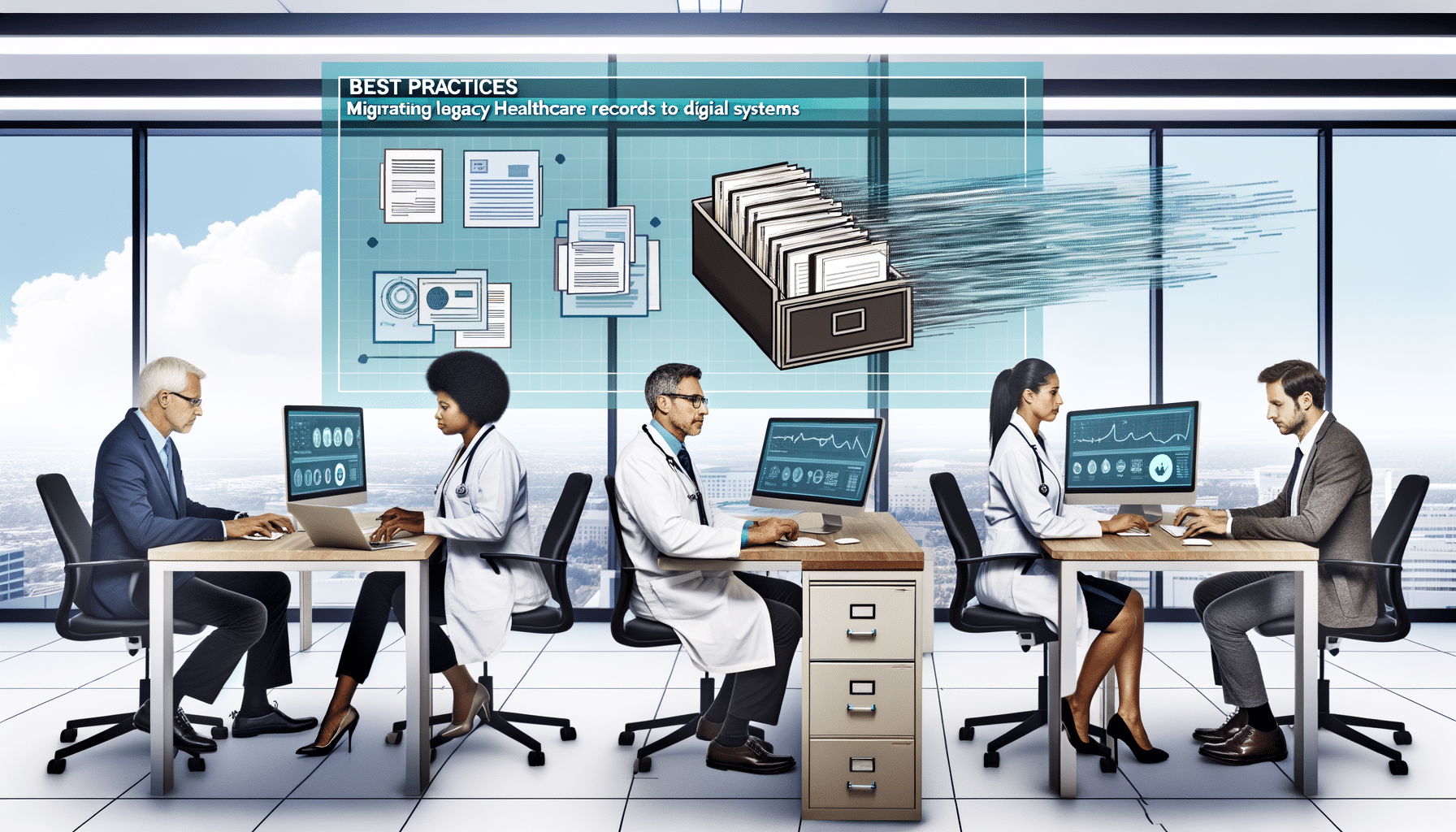- Digital Transition
- October 14, 2023
Best Practices for Migrating Legacy Healthcare Records to Digital Systems

As we step deeper into the digital era, the importance of transitioning from traditional paper-based legacy records to efficient digital systems cannot be overstated, especially in the healthcare sector. This transition is not just about keeping up with the times; it directly influences the accuracy, accessibility, and security of patient information. From improving patient care outcomes to ensuring compliance with regulatory standards, digitizing healthcare records offers myriad advantages. However, navigating this transformation can be daunting if not handled with strategic planning and careful execution.
Understanding the Challenges
Transitioning legacy records to digital systems in healthcare is fraught with challenges. Security, accuracy, and regulatory compliance are paramount issues that must be addressed. Protection of sensitive patient information is critical, as breaches can have severe legal and ethical consequences. Additionally, ensuring that the migrated data retains its accuracy and integrity is crucial to maintaining the trust of both patients and healthcare professionals.
With these challenges in mind, making the transition seamlessly involves a combination of technological savvy and strategic foresight. RecordsKeeper.AI, leveraging advanced AI and Blockchain technologies, offers the ideal solution for handling these complex tasks efficiently.
Developing a Comprehensive Migration Plan
A well-structured migration plan is the first step to success. Here’s a quick guide to keep your transition on track:
- Audit Existing Records: Start by conducting a thorough audit of your legacy records. Understand the categorization, volume, and type of data you’re planning to move. This helps in deciding the data mapping and structuring in the new digital environment.
- Set Objectives: Clearly define what you aim to achieve with the digital migration, such as improved data accessibility or enhanced security features.
- Timeline: Establish a realistic timeline for the migration process. Rushing the procedure can lead to oversight, while taking too long can cause unnecessary delays and expenses.
Remember, meticulous planning is critical to avoiding pitfalls during the migration phase.
Data Mapping and Cleansing
An essential component of the transition is data mapping, which involves mapping legacy data fields to the corresponding fields in the digital system. This step is critical for maintaining consistency and accuracy across the data landscape.
Concurrent with data mapping is data cleansing, where you identify and rectify any errors or duplications within the records. This ensures that what you migrate are pristine and valuable datasets, free from inaccuracies that could otherwise compromise healthcare delivery.
Choosing the Right Technology
The choice of technology can make or break your migration project. Here’s what to consider:
- Scalability: Select a digital system that can scale along with your organizational growth, handling increased data volumes and complexities effortlessly.
- Security: With healthcare records, security can’t be compromised. Choosing systems with robust security protocols like blockchain ensures tamper-proof, immutable records, enhancing trust and compliance.
- AI Integration: Incorporating artificial intelligence to automate categorization and retrieval of records can significantly enhance operational efficiency.
At RecordsKeeper.AI, our platform integrates these cutting-edge technologies, ensuring a smooth and secure migration.
Training Staff
The human element is as crucial as the technological aspect of this transition. Staff training enables smooth adoption of the new system, minimizing the learning curve that typically accompanies such transformations. Educate your team on the new system’s functionalities, the need for stringent data security, and the importance of data integrity to garner buy-in and ensure seamless operations.
Post-Migration Audit and Maintenance
Once the migration is complete, a thorough audit is vital. Run comprehensive checks to verify the integrity and accuracy of the migrated data. Any discrepancies should be promptly corrected to safeguard against future complications.
Regular maintenance and updates of the digital systems post-migration will ensure that the healthcare data remains up-to-date and resilient against emerging threats.
Conclusion
Transitioning legacy healthcare records to digital systems is a strategic move towards enhanced patient care and streamlined operations. With the right approach, tools, and technology, healthcare organizations can ensure a smooth transition, securing their data’s integrity and reliability. Embracing the digital wave opens up numerous opportunities for growth, efficiency, and compliance, allowing healthcare institutions to focus on delivering exceptional patient care.
At RecordsKeeper.AI, I am excited by the impact we can make in this field, empowered by AI and blockchain technology. Join me in transforming healthcare records into strategic assets—explore how RecordsKeeper.AI can redefine your record management experience today.
Toshendra Sharma is the visionary founder and CEO of RecordsKeeper.AI, spearheading the fusion of AI and blockchain to redefine enterprise record management. With a groundbreaking approach to solving complex business challenges, Toshendra combines deep expertise in blockchain and artificial intelligence with an acute understanding of enterprise compliance and security needs.
Archives
- January 2025
- December 2024
- November 2024
- October 2024
- September 2024
- August 2024
- July 2024
- June 2024
- May 2024
- April 2024
- March 2024
- February 2024
- January 2024
- December 2023
- November 2023
- October 2023
- September 2023
- August 2023
- July 2023
- June 2023
- May 2023
- April 2023
- March 2023
- February 2023
- January 2023
- December 2022
- November 2022
- October 2022
- September 2022
Want to get more content like this?
Signup to directly get this type of content to your inbox!!
Latest Post
Document Control for Equipment Maintenance
- January 20, 2025
Managing Records for Multiple Clients
- January 19, 2025
Handling Conference Documentation
- January 18, 2025
Setting Up Department Record Reviews
- January 17, 2025





